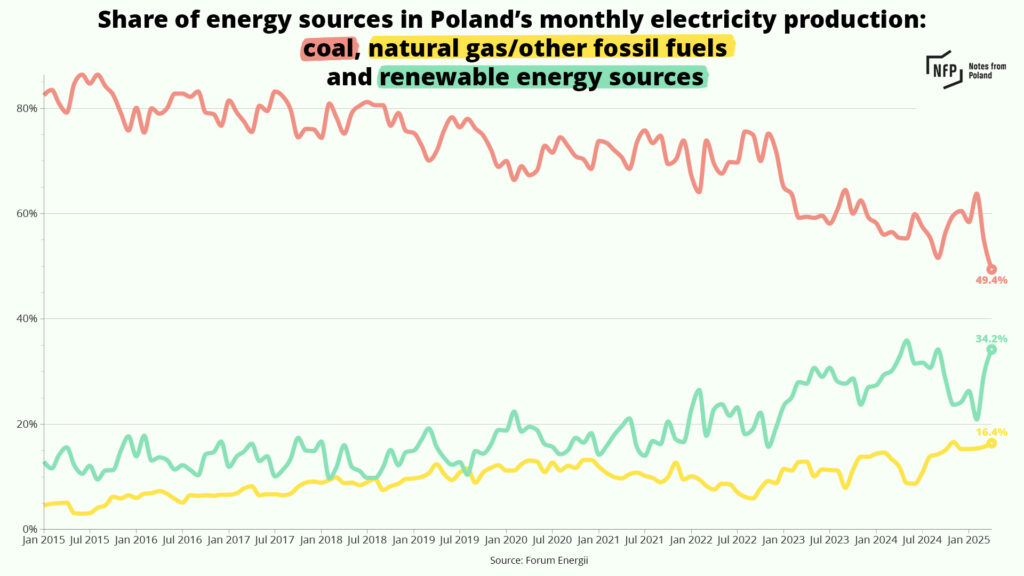Poland’s monthly coal in energy mix falls below 50% for first time

Poland’s share of electricity generated by coal last month fell below 50% for the first time, marking a significant milestone in the country’s ongoing transition towards cleaner energy sources.
According to a report by Forum Energii, an energy think tank, electricity produced from coal in April 2025 amounted to 6.5 terawatt-hours (TWh), accounting for 49.4% of the total energy mix. This represents an 18.9% decrease from March and a 9.6% drop compared to the same month in 2024.
The figures come against a backdrop of sluggish progress by the government in advancing the energy transition, with continued delays in delivering key policy frameworks.

Forum Energii described recent changes in the electricity mix as “unprecedented”, noting that the use of coal had fallen by 29.9 percentage points between April 2015 and April 2025.
The report showed that hard coal generation dropped to 4 TWh in April, down 20.1% month-on-month and 10.9% year-on-year. Brown coal output fell to a record low of 2.5 TWh, a 16.8% fall from March and a 7.2% decline compared with April 2024.
Meanwhile, electricity generation from natural gas increased year-on-year. Gas-fired and combined heat and power (CHP) plants produced 1.9 TWh in April, a 5.4% fall compared with March but a 44.2% rise year-on-year.
Overall electricity demand also fell, reaching 12.3 TWh in April, down from 13.4 TWh a year earlier. Forum Energii said this was the second-lowest level of monthly demand ever recorded.
As a result, the share of renewable energy sources (RES) in electricity generation rose to 34.2% in April, up 4.8 percentage points from March and 1.5 percentage points higher than in April 2024. Total RES generation reached 4.5 TWh.
“The systematic development of renewables means that the gap between the use of coal and RES in the system is shrinking ever faster,” the think tank said.
Wind energy accounted for 37.2% of RES output, or 1.7 TWh, a decrease of 20.5% year-on-year and down 8.8% from the previous month. Solar installations produced 1.9 TWh, making up 42.1% of renewable output – a 28.7% increase month-on-month and 32.4% more than in April 2024.
Biomass generation stood at approximately 0.8 TWh in March, while hydro power contributed 0.1 TWh. According to Forum Energii, renewables were responsible for up to 77% of electricity consumption during the highest hourly peak in April.
Poland generated a record 29% of its electricity from renewables in 2024, up from 26% the previous year.
But coal continues to be the main source of power, accounting for almost 57% of Poland's energy mix, the highest proportion in the EUhttps://t.co/B9Uj0uLSxN
— Notes from Poland 🇵🇱 (@notesfrompoland) January 2, 2025
Last year, Poland produced a record 29% of its electricity from renewables, up from 26% in 2023 and under 10% in 2015. Onshore wind accounted for 14.9% of electricity production last year, followed by solar at 11%. However, coal still generated 56.7% of power in 2024.
The former PiS government in 2023 outlined plans to produce 51% of electricity from renewables by 2040, with a further 23% coming from Poland’s first-ever nuclear power stations. It also launched efforts to build the country’s first offshore wind farms in the Baltic Sea.
The new coalition government, headed by Prime Minister Donald Tusk and in office since December 2023, pledged to accelerate the energy transition. However, it failed to pass any major legislation to support that goal in its first year of being in power.
When Donald Tusk’s government came to power, it promised to accelerate Poland's move away from reliance on coal.
But, after a year in office, the ruling coalition has failed to enact a single law that would significantly advance the energy transition https://t.co/TKFfoeAoKv
— Notes from Poland 🇵🇱 (@notesfrompoland) January 17, 2025
While some steps have since been taken – including the approval of long-delayed reforms to ease restrictions on onshore wind farm construction and an agreement with US companies to continue work on Poland’s first nuclear plant – progress on strategic policy planning remains limited.
The government has not yet released an updated Polish Energy Policy to 2040 or a revised national energy and climate plan. Poland missed a June 2024 deadline to submit the latter to the European Commission.
In November, the Commission launched an infringement procedure against Poland and 12 other EU member states for failing to meet the deadline. According to the Polish Press Agency (PAP), the climate ministry completed public consultation on its draft plan on 28 February. The document is expected to be submitted to Brussels by June.
Poland’s government has approved a bill that would make it easier to build wind farms by reducing the distance from existing buildings that turbines can be installed
It says the measures would help double wind capacity by 2030 and lower electricity prices https://t.co/MiRrEOv9ml
— Notes from Poland 🇵🇱 (@notesfrompoland) March 22, 2025
Main image credit: Kelly / Pexels
notesfrompoland




![Korespondencja z Rzymu [ZDJĘCIA]](/_next/image?url=https%3A%2F%2Fzycie.pl%2Fstatic%2Ffiles%2Fgallery%2F561%2F1585960_1746517089.webp&w=3840&q=100)
